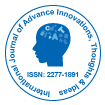Blockchain Technology: Revolutionizing Data Security and Transparency
Received: 01-Jan-2025 / Manuscript No. ijaiti-25-168542 / Editor assigned: 05-Jan-2025 / PreQC No. ijaiti-25-168542(PQ) / Reviewed: 19-Jan-2025 / QC No. ijaiti-25-168542 / Revised: 24-Jan-2025 / Manuscript No. ijaiti-25-168542(R) / Published Date: 30-Jan-2025 QI No. / ijaiti-25-168542
Abstract
Block chain technology, a decentralized and immutable digital ledger, is revolutionizing data security and transparency across various industries. This article examines how block chain applications are transforming sectors such as finance, supply chain management, healthcare, and governance by ensuring secure, tamper-proof, and transparent transactions. Key features like decentralization, cryptographic security, and consensus mechanisms are discussed. The paper also explores challenges including scalability, energy consumption, and regulatory uncertainties. Finally, it highlights future prospects of block chain as a foundational technology for trusted digital ecosystems
Keywords
Block chain, Data Security, Transparency, Decentralization, Cryptography, Supply Chain, Healthcare
Introduction
Block chain technology emerged with the creation of Bitcoin in 2008, introduced as a decentralized ledger that enables secure peer-to-peer transactions without a central authority. Since then, block chain has evolved beyond cryptocurrencies to offer transformative solutions for data security, transparency, and trust in various domains. Its unique characteristics—decentralization, immutability, and cryptographic validation—provide a robust framework to prevent fraud, unauthorized alterations, and ensure accountability [1-4].
Core Features of Block Chain Technology
- Decentralization Unlike traditional centralized databases controlled by a single entity, block chain operates on a peer-to-peer network where every participant holds a copy of the ledger. This eliminates single points of failure, reduces risk of data tampering, and increases resilience against cyber-attacks.
- Immutability and Transparency Once recorded, data entries on the block chain are cryptographically linked to previous records, making it nearly impossible to alter past transactions. This immutability enhances trust, while the transparency feature allows participants to verify transactions independently, fostering accountability [5].
- Consensus Mechanisms To validate new transactions, block chain networks employ consensus algorithms like Proof of Work (PoW) or Proof of Stake (PoS). These mechanisms ensure that the majority of participants agree on the ledger’s state, preventing fraudulent activities and double-spending.
Applications Across Industries
Finance and Banking
Block chain’s secure, transparent ledger simplifies and accelerates financial transactions, reducing costs associated with intermediaries. It supports cross-border payments, smart contracts automating agreements, and fraud detection. Many banks and finch firms are exploring block chain to increase efficiency and security.
Supply Chain Management
By recording every transaction or movement of goods on an immutable ledger, block chain enhances traceability and transparency in supply chains. This helps verify product authenticity, detect counterfeit goods, and improve recall management. Companies like Walmart and Maersk have piloted block chain solutions to track food safety and shipping containers [6, 7].
Healthcare
Block chain enables secure sharing of patient records while maintaining privacy and data integrity. It helps in verifying drug provenance to combat counterfeit medicines and streamlines clinical trial data management. The technology also supports telemedicine platforms by ensuring trustworthy patient data exchanges.
Governance and Voting
Block chain’s transparency and security can increase public trust in electoral systems by enabling tamper-proof digital voting. Additionally, it supports transparent management of public records such as land registries, reducing corruption and bureaucracy.
Challenges and Limitations
- Scalability Issues: Block chain networks like Bitcoin have limited transaction throughput and high latency, posing challenges for large-scale adoption. Solutions like layer-two protocols and sharding are being developed to address this.
- Energy Consumption: Proof of Work consensus demands significant computational power and energy, raising environmental concerns. Alternative algorithms like Proof of Stake offer energy-efficient options.
- Regulatory Uncertainty: The evolving legal landscape around block chain and cryptocurrencies creates challenges for widespread adoption. Clear regulations balancing innovation and security are needed.
Future Prospects
Block chain is poised to become the backbone of secure digital ecosystems, integrating with technologies like AI and IoT for automated, trustworthy operations. Decentralized finance (DeFi) platforms are disrupting traditional finance, while block chain-based identity solutions promise improved privacy and user control over personal data. As scalability and regulatory issues are resolved, block chain’s transformative impact will expand further [8-10].
Conclusion
Block chain technology’s decentralized, secure, and transparent nature is revolutionizing how data and transactions are managed across industries. Despite current challenges, ongoing innovations promise scalable, energy-efficient solutions and clearer regulations, paving the way for block chain to become a foundational technology in the digital age. Its potential to enhance trust, security, and efficiency offers a compelling vision for future data ecosystems.
Citation: Charlas D (2025) Block chain Technology: Revolutionizing Data Security and Transparency. Int J Adv Innovat Thoughts Ideas, 14: 313.
Copyright: 2025 Charlas D. This is an open-access article distributed under the terms of the Creative Commons Attribution License, which permits unrestricted use, distribution, and reproduction in any medium, provided the original author and source are credited.
Select your language of interest to view the total content in your interested language
Share This Article
Recommended Journals
Open Access Journals
Article Usage
- Total views: 386
- [From(publication date): 0-0 - Dec 12, 2025]
- Breakdown by view type
- HTML page views: 312
- PDF downloads: 74
